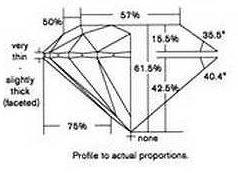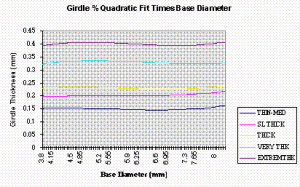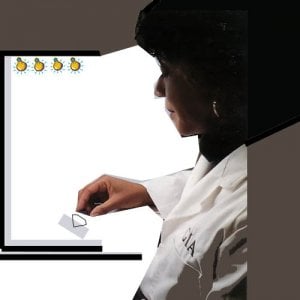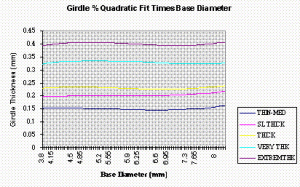belle
Super_Ideal_Rock
- Joined
- Nov 19, 2004
- Messages
- 10,285
I asked GIA and they responded along the lines of:
So my current belief appears accurate that the Facetware input of thin, medium, thick etc. is still based upon evaluation at the valleys in the usual manner.
Michael Cowing

Michael what I do not understand is that you seem to be having a fight over this.Date: 1/7/2006 7:55:58 PM
Author: michaelgem
What part of:
''It is important to note that there will be no change in the GIA Laboratory’s methods for assessing culet size and girdle thickness due to the introduction of the new cut grading system.''
do you not understand?
Michael Cowing


Hey Marty - that paragraph has been removed from the Facetware terms of use, so I believe people are at liberty to use it AND discuss it critically now.Date: 1/8/2006 12:19:55 AM
Author: adamasgem
“PUBLICITY. Licensee will not issue any press release or make any statement or announcement to the press, the public or any third party (including, without limitation, Licensee’s customers) which (i) reflects unfavorably on the Software or the performance of the Software, (ii) is false or misleading about GIA or the Software or (iii) is damaging to the reputation of GIA or the Software. This paragraph shall survive the termination of this Agreement.”
Ah but remember, FW will be judging how significantly the Jeep was painted. A nice two-tone might be fine, but big racing stripes or flames could result in a downgrade.
Now what they are doing internally in 2006, is anyones'' guess, but my intuition tells mes that a Jeep Wheel will get a medium girdle, just so that their paper reads right.. BUT THAT IS ONLY MY OPINION

"It is important to note that there will be no change in the GIA Laboratory’s methods for assessing culet size and girdle thickness due to the introduction of the new cut grading system."
Date: 1/8/2006 1:07:31 AM
Author: JohnQuixote
Hey Marty - that paragraph has been removed from the Facetware terms of use, so I believe people are at liberty to use it AND discuss it critically now.Date: 1/8/2006 12:19:55 AM
Author: adamasgem
“PUBLICITY. Licensee will not issue any press release or make any statement or announcement to the press, the public or any third party (including, without limitation, Licensee’s customers) which (i) reflects unfavorably on the Software or the performance of the Software, (ii) is false or misleading about GIA or the Software or (iii) is damaging to the reputation of GIA or the Software. This paragraph shall survive the termination of this Agreement.”
Well, I guess my prior commentary a while ago regarding that on another trade commentary forum did some good thenI wonder if they took my suggestion and fired the idiot who thought it up, as well as the the idiots who approved it..

Ah but remember, FW will be judging how significantly the Jeep was painted. A nice two-tone might be fine, but big racing stripes or flames could result in a downgrade.
Now what they are doing internally in 2006, is anyones' guess, but my intuition tells mes that a Jeep Wheel will get a medium girdle, just so that their paper reads right.. BUT THAT IS ONLY MY OPINION
(a little humor)
Not really humor, don't you realize that FARCEWARE was probably intended to make the broadest range of stones appear good on paper, otherwise you can sell your paper.. You develop the answer you want to give, and then tailor the test conditions to give you that answer proving the point you "scientifically" wanted to "prove", that's not to say expressly that that is what happened, but all we see everywhere we look is an opening up of every seemingly "standard" we were ever taught.....
If that was their goal, then having the light come from one area above the stone, with relative darkness avbove and behind the observer would certainly make most shallower, tending to be lower yeilding, stones look pretty bad.Date: 1/8/2006 3:48:01 AM
Author: adamasgem
Not really humor, don''t you realize that FARCEWARE was probably intended to make the broadest range of stones appear good on paper, otherwise you can sell your paper.. You develop the answer you want to give, and then tailor the test conditions to give you that answer proving the point you ''scientifically'' wanted to ''prove'', that''s not to say expressly that that is what happened, but all we see everywhere we look is an opening up of every seemingly ''standard'' we were ever taught.....

It think it was prudent of them to remove the 'Publicity' statement.Date: 1/8/2006 3:48:01 AM
Author: adamasgem
Date: 1/8/2006 1:07:31 AM
Author: JohnQuixote
Hey Marty - that paragraph has been removed from the Facetware terms of use, so I believe people are at liberty to use it AND discuss it critically now.Date: 1/8/2006 12:19:55 AM
Author: adamasgem
“PUBLICITY. Licensee will not issue any press release or make any statement or announcement to the press, the public or any third party (including, without limitation, Licensee’s customers) which (i) reflects unfavorably on the Software or the performance of the Software, (ii) is false or misleading about GIA or the Software or (iii) is damaging to the reputation of GIA or the Software. This paragraph shall survive the termination of this Agreement.”
Well, I guess my prior commentary a while ago regarding that on another trade commentary forum did some good thenI wonder if they took my suggestion and fired the idiot who thought it up, as well as the the idiots who approved it..

Ah but remember, FW will be judging how significantly the Jeep was painted. A nice two-tone might be fine, but big racing stripes or flames could result in a downgrade.
Now what they are doing internally in 2006, is anyones' guess, but my intuition tells mes that a Jeep Wheel will get a medium girdle, just so that their paper reads right.. BUT THAT IS ONLY MY OPINION
(a little humor)
Not really humor, don't you realize that FARCEWARE was probably intended to make the broadest range of stones appear good on paper, otherwise you can sell your paper.. You develop the answer you want to give, and then tailor the test conditions to give you that answer proving the point you 'scientifically' wanted to 'prove', that's not to say expressly that that is what happened, but all we see everywhere we look is an opening up of every seemingly 'standard' we were ever taught.....
I don''t buy in to all this unproductive vituperation, but I am in concert with and have made related observations to these remarks of Garry''s:
I believe that the lighting and grey stone tray were attempts to obtain standard lighting conditions close to typical observation conditions, so that results would better correlate to perceived reality. I don''t believe it was designed to produce some desired result.
For one thing, GIA has explained that a black tray overemphasized the negative appearance due to light leakage, while a white tray disguised it. The grey tray was thus an attempt to obtain better correlation with perception.
The standard lighting chosen, as Garry points out, would show the poor performance of shallow cut diamonds due to retro-reflection from the vicinity of the observer’s head. It must have made clear the fallacy in their erroneous belief stated in their original 1998 research report that I discussed in the Journal of Gemmology e.g.:
http://www.acagemlab.com/Article1/Article1.htm#brill024
"In general, WLR increases as crown angle decreases. ... These results suggest that, at the reference proportions, a diamond with a 23° crown angle is brighter than a stone with any other crown angle greater than 10°. ... Ironically, the highest WLR values are obtained for a round brilliant with no crown at all" GIA
Michael Cowing

Date: 1/8/2006 5:12:37 PM
Author: adamasgem
I am wondering if the NEW GIA/GTL reports giving the 'measurements' and angles of of the stone, mimic the FARCEWARE(TM) rounding 'standards' (or lack thereof), ie
1) Measure the stone using a Helium/Sarin/Ogi or whatever
2) Average the measurements
3) Re Round the averaged measurements to numbers of convenience..
If so, I ask the question, would these GIAGTL 'reports' constitute a FRAUD on the consumer ?, being intentionally misleading, so much so that the numbers would then be useless if the consumer wanted to use GIA 'measurements', to get another 'opinion'.
The example of GIA/GTL paper posted prior on this thread seems to suggest that this is what is happening.. But, again, GIA legal has probably tried to cover this up with the 'fine print' on the back of the report.. I'd appreciate if someone with a new report would scan the 'fine print' on the back...
RE: Maybe the ‘fine print’ you''re hoping for will be in a large font, bold and highlighted.Date: 1/8/2006 5:53:57 PM
Author: JohnQuixote
Date: 1/8/2006 5:12:37 PM
Author: adamasgem
I am wondering if the NEW GIA/GTL reports giving the ''measurements'' and angles of of the stone, mimic the FARCEWARE(TM) rounding ''standards'' (or lack thereof), ie
1) Measure the stone using a Helium/Sarin/Ogi or whatever
2) Average the measurements
3) Re Round the averaged measurements to numbers of convenience..
If so, I ask the question, would these GIAGTL ''reports'' constitute a FRAUD on the consumer ?, being intentionally misleading, so much so that the numbers would then be useless if the consumer wanted to use GIA ''measurements'', to get another ''opinion''.
The example of GIA/GTL paper posted prior on this thread seems to suggest that this is what is happening.. But, again, GIA legal has probably tried to cover this up with the ''fine print'' on the back of the report.. I''d appreciate if someone with a new report would scan the ''fine print'' on the back...
Marty, I wonder this too.
We, and other vendors, provide a Sarin scan for every diamonds independently of lits ab report. We have always maintained that the lab report is the document of authority (in the case where there may be a slight disparity between our scan and the lab’s).
If the new GIA report includes rounded proportions it is - at the least - a weaker technical document than a Sarin scan and - at the most - misleading to any who don’t realize the implications. Perhaps that’s not the case, and the numbers on the report are actual Sarin numbers (?)
I think fraud is a strong word but I agree, if this is what is being done, there should be obvious notation to that effect. Maybe the ‘fine print’ you''re hoping for will be in a large font, bold and highlighted.
Thanks Belle..Date: 1/8/2006 6:07:10 PM
Author: belle
the ''fine'' print

John,
RE your comments:
>>> I am surprised at the rounding in FW. 5% increments would seem to make the inclusion of stars/lgf a token gesture. Moreover, PA in increments of .2 & CA in increments of .5 can result in wholly different judgments, depending on what direction you take the rounding if an angle is in the middle.
I think you would agree that the rounding in FW creates dichotomy when there is no accompanying instruction to resolve numbers falling inside the increments, wouldn''t you? <<<
I don''t see your comments as vituperative. Your point deserves addressing. IMO, considering the importance of lower half length to the diamond''s optical performance and thus its beauty, this parameter should be measured and specified more accurately than rounding to 5% increments. GIA, on the other hand, seems to find lower half length less critical than you and I, perhaps more a matter of taste. This is reflected in this seemingly coarse quantization.
We may find our concerns already addressed, but likely not to your satisfaction, on GIA''s website. I seem to remember reading or being told that the choice of increments for each parameter related to what I think of as just noticeable differences (JND''s) obtained by statistical analysis of their 70+ thousand paired comparison database. It was also said to relate to an analysis of the accuracy obtainable in practice for each parameter during laboratory measurement using the Sarin machines.
I have made inquiries, and I''ll let you know if I hear or find anything more definitive.
Michael Cowing
Has anyone bookmarked the link to the rapaort article that gIA wrote? - They discussed their reasons (excuses) for such wide tolerances.Date: 1/8/2006 11:52:01 PM
Author: michaelgem
...considering the importance of lower half length to the diamond''s optical performance and thus its beauty, this parameter should be measured and specified more accurately than rounding to 5% increments. GIA, on the other hand, seems to find lower half length less critical than you and I, perhaps more a matter of taste. This is reflected in this seemingly coarse quantization.
We may find our concerns already addressed, but likely not to your satisfaction, on GIA''s website. I seem to remember reading or being told that the choice of increments for each parameter related to what I think of as just noticeable differences (JND''s) obtained by statistical analysis of their 70+ thousand paired comparison database. It was also said to relate to an analysis of the accuracy obtainable in practice for each parameter during laboratory measurement using the Sarin machines.
Michael Cowing
I just opened the attachment on Marty''s article - interesting.Date: 1/8/2006 12:43:48 AM
Author: adamasgem
Regarding FARCEWARE(TM)..
One of the thing I first noticed in what they publicly published regarding thier new cut grade was that an extremely thin girdle (i.e. knife edge) could get a VERY GOOD cut grade, so I did a little searching and came across this page from their internal lab manual of 1998 (which I just happen to have had a copy of). People should find it interesting reading.
Now based on what I had previously documented about girdle thickness issues on my web site I came up with (based on GIA published information) the boundaries (Measured at the minimums of the scallops) in the mid 90''s of
Thin: Less than 0.15 millimeters
Medium: between 0.15 and 0.20 millimeters
Slightly Thick: between 0.20 and 0.23 millimeters
Thick: between 0.23 and 0.33 millimeters
Very Thick: between 0.33 and 0.40 millimeters
Extremely Thick: greater than 0.40 millimeters
By 1998 they had internally stretched the grading of girdle thickness, based on the attached such that, for a 1 carat stone, it appears that>>>
Very Thin: (New <0.05mm)
Thin or less: Less than 0.15 millimeters (New 0.05mm-0.1mm)
To be called thin or less the stone’s girdle is allowed to be much thinner than before
Medium: between 0.15 and 0.20 millimeters (New 0.1mm-0.15mm)
To be called medium, the stone’s girdle is allowed to be much thinner than before
Slightly Thick: between 0.20 and 0.23 millimeters (New 0.15mm-0.2mm)
To be called slightly thick, the stone’s girdle is allowed to be much thinner than before
Thick: between 0.23 and 0.33 millimeters (New 0.2mm-0.3mm)
The thick range is the same width, but can be thinner than before
Very Thick: between 0.33 and 0.40 millimeters (New 0.3mm-0.5mm)
The very thick range has widened and can be much thicker than before
Extremely Thick: greater than 0.40 millimeters (New >0.5mm)
To be called Extremely Thick, the girdle can be 25% thicker than before
Now what they are doing internally in 2006, is anyones'' guess, but my intuition tells mes that a Jeep Wheel will get a medium girdle, just so that their paper reads right.. BUT THAT IS ONLY MY OPINION
More on FARCEWARE(TM) later



Date: 1/8/2006 11:52:01 PM
Author: michaelgem
I seem to remember reading or being told that the choice of increments for each parameter related to what I think of as just noticeable differences (JND''s) obtained by statistical analysis of their 70+ thousand paired comparison database.

Valeria..Date: 1/9/2006 4:46:39 AM
Author: valeria101
Date: 1/8/2006 11:52:01 PM
Author: michaelgem
I seem to remember reading or being told that the choice of increments for each parameter related to what I think of as just noticeable differences (JND''s) obtained by statistical analysis of their 70+ thousand paired comparison database.
Is GIA''s the first cut grading system that acknowledges any sort of rounding and error level in their measurements? JND?
It must be that your question has been directed to experts, not me. Would it be ok to clarify what the either/or fork is about? I have some trouble understanding why metrics and models are mutually exclusive.Date: 1/9/2006 1:42:42 PM
Author: oldminer
You won''t get to where you want to go by choosing the wrong fork in the road. ... You have not gone that far down the wrong path that you can''t readily go back and consider direct assessment as the more useful and most honest grading technology.
